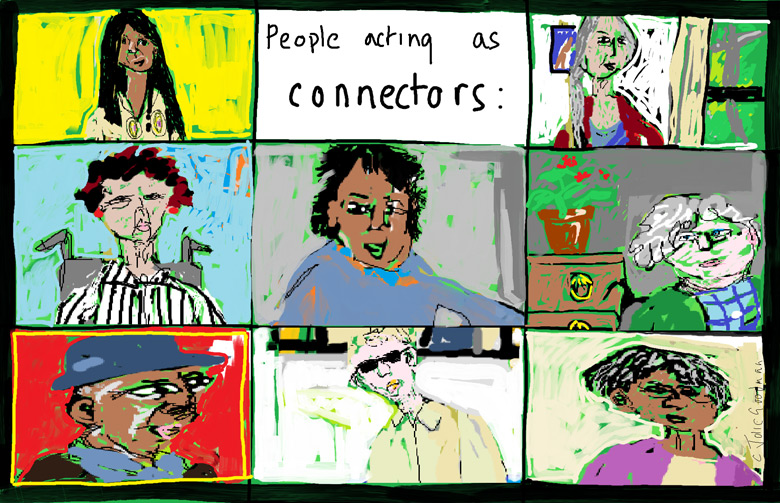Relationships have to start somewhere and require connections to be made between people, groups and organisations who may not have been connected in the past or whose relationships have been uneasy or in conflict. For example, the development of new housing can be a focus for conflict between organisations putting forward plans and people already settled in an area.
Equally there can be groups of citizens and micro-enterprises who want to progress mutual plans such as co-housing, self-build or a therapeutic community but do not know who to connect with to get things started.
Investment in people with the skills at fostering relationships and knowledge of a local area, services and population can be key to making progress in the development of cohesive communities, HAPPI and the lifetime homes (opens new window).
And with Covid-19 in mind, we have seen how making connections and sustaining relationships can be underpinned through the greater use of digital technology. From setting up WhatsApp groups to instant messaging.
One of the strengths of the Local Area Coordination (LAC) (opens new window) model is that it builds on the fact that in most communities there are individuals who know a lot about their locality and the services and groups active within it. These individuals enable a connection between people with mutual interests, knowledge and skills. The LAC approach is being developed in several areas of the UK and each belongs to a network.
A similar approach uses Community/Neighbourhood Connectors who link others in their local community with activities and organisations that can help improve their quality of life such as health services, community groups and organisations, social groups and activities.
- Neighbourhood networks: A model for community support (opens new window)
- Ever more needed? The role of the Leeds Neighbourhood Networks during the COVID-19 pandemic
- Housing LIN blog: Building communities – community building across Wigan’s extra care housing
- Embedding Community Circles in Support for Older People Living in Residential Care Homes or Extra Care
- Housing LIN blog: COVID-19 and sheltered housing schemes
- Appello briefing - 4 Reasons housing providers must revise their Telecare needs post COVID-19 in 4 guides
- Inspirational Achievement - L&Q Living's Response to Coronavirus
- Housing LIN blog: Life after COVID-19. Collaboration for a Better Future - Tomorrow will be a Better Day
“It brought issues up, made room for action, and now we know what to do that makes a difference.”
Alan, circle member
Case Studies
- Project Smith, Lambeth (opens new window)
- Community Micro-Enterprises: As a driver of local economic development in social care
- Keyring (opens new window)
Keyring offers an innovative approach to supporting people. A KeyRing Network offers support through trained teams and volunteers. It promotes peer and community support options to enable people to become less reliant on services (including Keyring) - LiveWest: Community Connectors (opens new window)
Operating across South West England and a range of diverse communities, LiveWest's Community Connectors work closely within a number of urban and rural geographical areas to engage, listen to and skill up their customers and parties to produce action plans that put 'Neighbourhoods In Focus'.
Local authorities may decide to employ project workers to increase the range of people who are engaged in discussions and action about local developments. Sometimes they will provide funds to a local voluntary group or community organisation to employ such connectors. This can be especially valuable in rural areas where the population is spread out and households can be less connected. For example, the employment of Rural Housing Enablers has been successful in various areas as a way to tackle shortages of affordable housing.
Information about Rural Housing Enablers in North and East Yorkshire can be found in the HAPPI 4 report on page 24.


